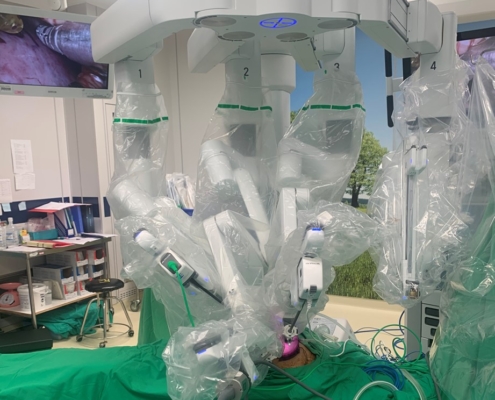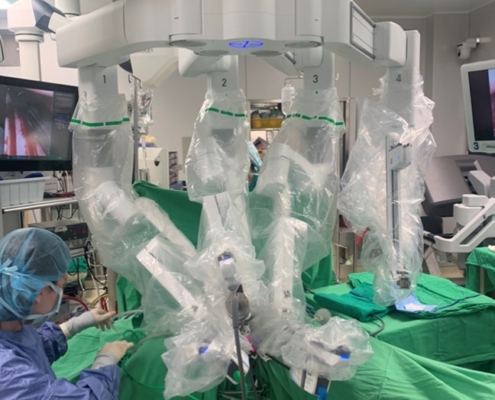达文西手术
Cheng Hsin General Hospital (CHGH) is dedicated to delivering exceptional care for a wide range of gynecological diseases. In 2018, we introduced the cutting-edge da Vinci Xi system, the fourth generation of our Robotic Surgical System. This technological advancement marked the beginning of our da Vinci program, empowering our medical team to carry out complex surgeries with remarkable success.

Da Vinci robotic surgery is a remarkable approach where a surgeon controls robotic arms from a console to perform complex procedures. This advanced system provides a 3D, magnified, and high-definition endoscopy image, enhancing visual depth during surgery and making minimally invasive procedures safer. With four accurate robotic arms, including a camera and surgical instruments, surgeons can operate with precision and without tremors. This robotic assistance enables surgeons to perform complex procedures that were previously challenging or impossible with laparoscopy.
At CHGH, our GYN department is at the forefront of embracing cutting-edge technology to advance patient care. We offer three distinct approaches in robotic surgery: multi-ports, RSS (robotic single site), and vNOTES robotic surgery (via the vagina).
multi-ports :
In multi-port robotic-assisted surgery, 3-5 small incisions are made, allowing dedicated robotic instruments to be inserted. This technique is particularly beneficial for challenging GYN conditions such as large fibroids, large uteri, large ovarian lesions, adhesions, and selected GYN malignancies.
RSS (robotic single site) :
For RSS (robotic single site), a single incision of 1.5-2cm is made at the umbilicus. An additional single port system is inserted to prevent air leakage during pneumoperitoneum. All robotic arms are placed within this single wound, resulting in excellent aesthetic outcomes and reduced post-operative pain for patients.
vNOTES robotic surgery :
vNOTES robotic surgery involves making a single 2-3cm incision in the vagina, just below or above the cervix uteri (known as posterior or anterior colpotomy). A single port system is then inserted into the vaginal incision, allowing the surgeon to perform robotic surgery via the vagina. This surgical route offers perfect aesthetic results (no visible external wound) and even less pain compared to RSS and multi-port robotic surgery.
Robotic surgery has made minimally invasive procedures possible for challenging cases.
It provides several advantages over traditional open approaches, including better wound healing, less noticeable scars, reduced pain, decreased blood loss, shorter hospital stays, and faster recovery.
Robotic surgery has made minimally invasive procedures possible for challenging cases.
It provides several advantages over traditional open approaches, including better wound healing, less noticeable scars, reduced pain, decreased blood loss, shorter hospital stays, and faster recovery.
By incorporating robotic technology into our GYN department, we aim to deliver the highest standard of care, ensuring improved outcomes, enhanced patient comfort, and a quicker return to everyday life. However, despite all the benefits robotic surgery provides, it still involves risks similar to those of the conventional open approach. Additionally, all minimally invasive surgeries carry the uncertainty of conversion to open surgery.










 周一~周五 8am~5pm.
周一~周五 8am~5pm.


